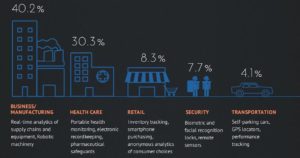IoT isn’t something you can ignore and hope that it just goes away. The organizations that will take the time to apply IoT to gather data, analyze it, and turn it into actionable insights will gain a competitive advantage over those that don’t.
From smart inventory control sensors, to smart appliances that factory safety, to devices that control workplace systems, the Internet of Things (IoT) and its interconnected ways are rapidly making their way into our work.
By 2020, the number of Internet-connected “things” is expected to reach 50 billion. And even with those astounding numbers, the low-hanging fruit of IoT has yet to even be picked. In fact, experts say that just 0.06% of all devices that could potentially leverage IoT are actually doing so. That means that the remaining 99.94% are ripe and ready for optimization.

By bridging the gap between the physical and the digital world — mainly through the use of sensors and actuators — IoT is helping all of us all work smarter, better, faster, and more efficiently. That’s because IoT gives companies dozens of new informational “touchpoints” real-time.
Sensors can be put on practically anything. For example, a tractor-trailer that’s moving over the road and filled with perishable goods can be equipped with sensors that report back to headquarters. If the temperature in the truck increases by just 5 degrees, the issue can be quickly mitigated. Consider the following few examples:
No more “turning the lights out” when you walk out of a room. Large commercial buildings use a lot of energy, with retail, office, education, healthcare, and lodging consuming the most electricity and natural gas, according to the U.S. Energy Information Administration.This presents a huge opportunity for IoT-driven devices that use sensors to turn lights off automatically, change the thermostat when no one’s in the room, or even boot up conference-call hardwarea few minutes before a meeting starts. Through these smart sensors, companies can not only save money on their energy bills, but then can also reduce their carbon footprints and reduce pressure on employees to “turn the lights out” when they leave an empty room.
Big Brother-like monitoring of device usage. The influx of mobile devices in the workplace has been both a blessing and curse for the companies that distribute, track, and maintain them. Where just five years ago a company-issued cell phone was pretty much untraceable, mobile device management (MDM) enabled by IoT has put the power in the hands of the companies that are doling out those devices. For example, the devices can be controlled and managed remotely, thus adding new levels of security and administrative control. Should a device go missing, it can be locked down and wiped clean before anyone gets their hands on its data.
Solutions that tackle the “big data” monster. We’re producing more data than ever — roughly 2.5 quintillion bytes of data every dayto be exact, or just enough to fill 10 million Blue Ray discs. This proliferation has made understanding big data and figuring out how to leverage it important charges for companies across all industries. Many of those firms will turn to IoT products to help them tackle the big data monster. A company with multiple data centers can use IoT-enable sensors to not only monitor their facilities, but also to automate tasks like provisioning.These sensors and their connected technologies will also help companies ferret out the data that’s actually actionable.
Where Should You Begin?
IoT allows us to rethink our workplace. “IoT has the potential to transform the way companies make products, track goods and assets in the supply chain, monitor the performance of systems in the field, provide security for employees and facilities,” HBR notes,“and provide services to customers.”
All that starts with self-examination. Start by taking these steps:
Identify your organization’s vision.Don’t just layer on IoT for the sake of it. Make it a part of your firm’s larger vision for success. If the devices you’re investing in don’t provide value and don’t align with that vision, then move onto something else.
Ask yourself the tough questions.How can your business operations be automated? What key pain points with IoT help solve? How can it be used to, say, offset the labor shortage? And, which IoT components (e.g., predictive analytics, preventative maintenance, metering/measurement, etc.) will best address these and other organizational issues?
Develop a viable business use case. Look at connected operations (sensors or devices linked to a network), remote monitoring, asset management, predictive analytics, preventative maintenance, and other IoT-supported use cases that will help your company work smarter and faster. Do your homework and come up with specific ways that these technologies can enable a smarter, more connected work environment.
Still in its relative infancy, IoT aims to create a faster, better and in more innovative workplace. It’s not something you can ignore and hope that it just goes away. The organizations that will take the time to apply IoT to gather data, analyze it, and turn it into actionable insights will gain a competitive advantage over those that don’t.
The assumptions you’re making about the future are embedded directly in the way you’re doing things right now. Closely reexamining your existing processes can make it easier to see the type of future that your current strategy assumes you’re heading toward.
Copyright © 2018 by Faisal Hoque. All rights reserved.















